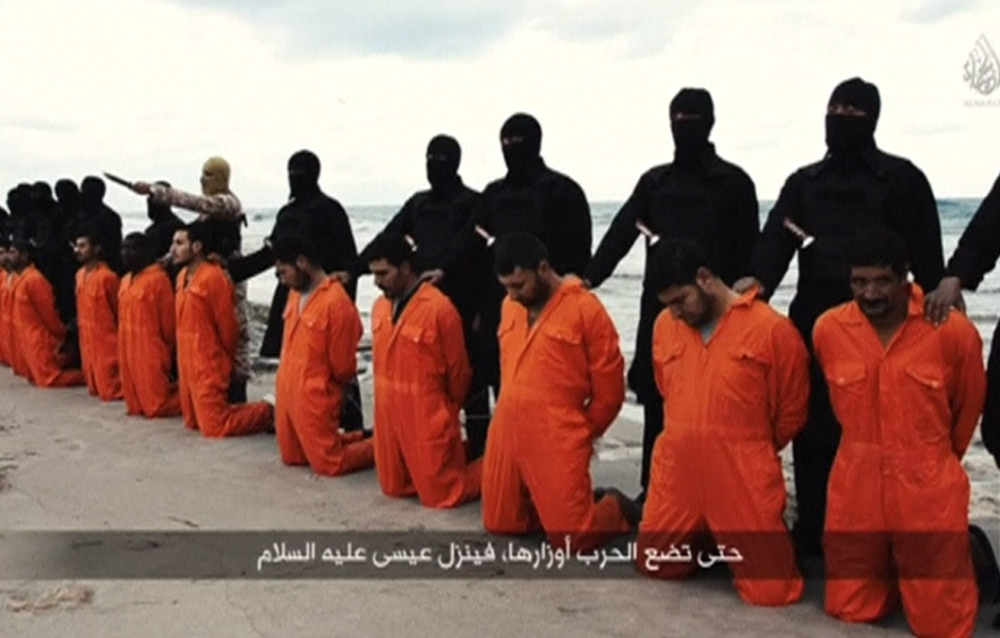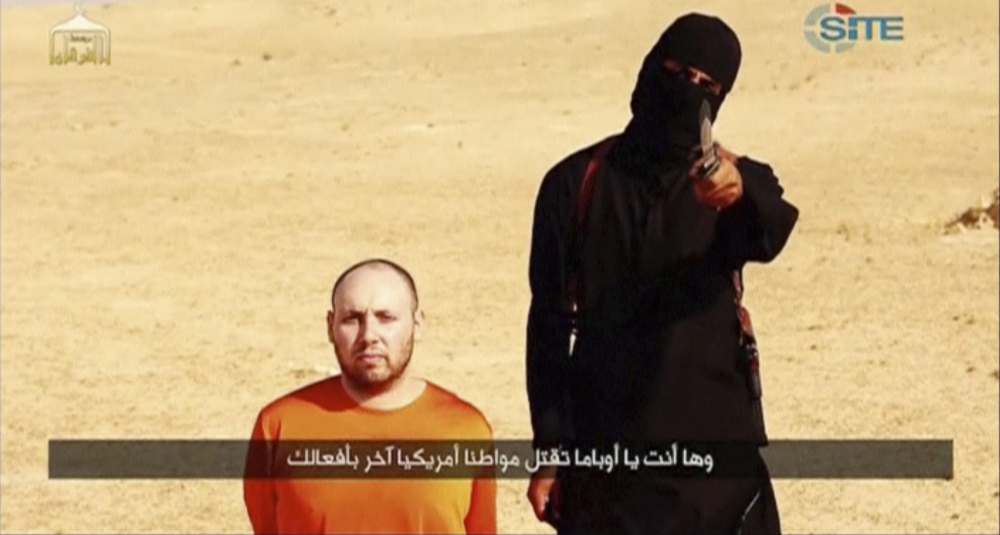When a lone terrorist slaughtered 38 tourists at a Tunisian resort on June 26, the Islamic State turned to one of America’s leading social-media companies to claim credit and warn of more attacks on the world’s nonbelievers.
“It was a painful strike and a message stained with blood,” the Islamic State announced on Twitter following the massacre in Sousse, a popular destination for Europeans on the Mediterranean. “Let them wait for the glad tidings of what will harm them in the coming days, Allah permitting.”
Three days before the assault, the Islamic State relied on Google’s YouTube, to promote a grisly propaganda video of three separate executions. Men accused of cooperating with U.S.-coordinated airstrikes in Iraq and Syria are seen being incinerated in a car, drowned in a cage and decapitated by explosive necklaces.
Versions of it would remain on YouTube, even as company executives proclaimed that Google would not provide a “distribution channel for this horrible, but very newsworthy, terrorist propaganda.”
As the Islamic State, also known as ISIS and ISIL, continues to hold large parts of Iraq and Syria and inspire terrorist attacks in more and more countries, it has come to rely upon U.S. social-media companies to summon fresh recruits to its cause, spread its propaganda and call for attacks.
“We also have to acknowledge that ISIL has been particularly effective at reaching out to and recruiting vulnerable people around the world, including here in the United States,” President Obama said July 6 at the Pentagon. “So the United States will continue to do our part, by working with partners to counter ISIL’s hateful propaganda, especially online.”
FREE SPEECH EXPLOITED
The social-media savvy of the militant group is raising difficult questions for many U.S. firms: How to preserve global platforms that offer forums for expression while preventing groups such as the Islamic State from exploiting those free-speech principles to advance their terrorist campaign.
“ISIS has been confronting us with these really inhumane and atrocious images, and there are some people who believe if you type ‘jihad’ or ‘ISIS’ on YouTube, you should get no results,” Victoria Grand, Google’s director of policy strategy, told The Washington Post. “We don’t believe that should be the case. Actually, a lot of the results you see on YouTube are educational about the origins of the group, educating people about the dangers and violence. But the goal here is how do you strike a balance between enabling people to discuss and access information about ISIS, but also not become the distribution channel for their propaganda?”
Some say the companies are not going far enough.
“They are being exploited by terrorists,” Assistant Attorney General for National Security John Carlin said. “I think there is recognition now that there is a problem, and so we’re starting to see people at the companies address additional resources. But more needs to be done because we’re still seeing the threat, and the threat is increasing, not decreasing.”
A field analysis in May by the Department of Homeland Security warns that the Islamic State’s use of social media is broadening the terrorist group’s reach.
“ISIL leverages social media to propagate its message and benefits from thousands of organized supporters globally online, primarily on Twitter, who seek to legitimize its actions while burnishing an image of strength and power,” according to the analysis. “The influence is underscored by the large number of reports stemming from social media postings.”
In Europe, some governments are requiring social-media companies to block or remove terror-related posts.
sELF-REGULATTED SOCIAL MEDIA
Earlier this month, the Senate Intelligence Committee approved a bill that would require social-media companies to alert federal authorities when they become aware of terrorist-related content on their sites. It would not require firms to monitor any users or their communications.
Putting more pressure on the social-media companies, a U.N. panel last month called on the firms to respond to accusations that their sites are being exploited by extremists.
In the United States, government regulation of speech, regardless of how offensive or hateful, is generally held to be unconstitutional. The social-media companies have been governing how and when to block or remove terror-related content.
The revelations of former National Security Agency contractor Edward Snowden about U.S. government surveillance has also made the tech companies wary of cooperating with Washington.
Facebook has adopted a zero-tolerance policy and, unlike other social-media companies, proactively removes posts related to terrorist organizations. Facebook also relies on its users to alert the company to posts that promote or celebrate terrorism and hires screeners to review content.
“We don’t allow praise or support of terror groups or terror acts, anything that’s done by these groups and their members,” said Monika Bickert, a former federal prosecutor who heads global policy management for Facebook.
Of all the large social-media companies, Twitter has been the most outspoken about protecting freedom of speech on its platform. Still, the company recently updated its abuse policy, stating that users may not threaten or promote terrorism.
“Twitter continues to strongly support freedom of expression and diverse perspectives,” according to a Twitter official, who spoke on the condition of anonymity because of recent death threats against employees by Islamic State supporters. “But it also has clear rules governing what is permissible. . . . The use of Twitter by violent extremist groups to threaten horrific acts of depravity and violence is of grave concern and against our policies, period.”
Another challenge for the companies: It is often difficult to distinguish between communiques from terrorist groups and posts by news organizations and legitimate users. Internet freedom advocates also note that much of what groups like the Islamic State are posting can be seen as part of the historical record – even though many of the photographs and videos are horrific.
REPUTABLE NEWS ALSO SHOCKS
They point to the iconic 1968 Associated Press photograph of South Vietnam’s national police commander shooting a suspected Viet Cong fighter in the head. They wonder how that Pulitzer Prize-winning image, which came to symbolize the chaos and brutality of the Vietnam War, would be handled in the age of social media and modern digital warfare.
“You want to live in a world where people have access to news – in other words, documentary evidence of what is actually happening,” said Andrew McLaughlin, a partner in the start-up firm Betaworks in New York. “And an ISIS video of hostages being beheaded is both an act of propaganda and is itself a fact. And so if you’re a platform, you don’t want to suppress the facts. On the other hand, you don’t want to participate in advancing propaganda.”
Before the rise of social media, many of the three dozen video and audio messages Osama bin Laden issued were recorded in remote locations, smuggled out by couriers, and aired on what was then a largely unknown TV station based in Qatar called Al Jazeera. Weeks could pass between the time when bin Laden spoke and when he was heard.
“It was a different time,” said Steven Stalinsky, executive director of the Middle East Media Research Institute. “The jihadi groups decided what could be posted and released. Twitter became the way around the forums. It became the wild west of jihad.”
Before his death, bin Laden had come to recognize the revolution that followed the launch of Facebook in 2004 and Twitter in 2006.
“The wide-scale spread of jihadist ideology, especially on the Internet, and the tremendous number of young people who frequent the Jihadist Web sites are a major achievement for jihad,” bin Laden wrote in a May 2010 letter that was later found by U.S. Special Operations forces inside his Pakistan compound.
Counterterrorism officials say the constantly evolving social-media landscape is providing more places for groups such as the Islamic State to hide in cyberspace. Finding and shutting down sites and accounts is starting to resemble a carnival game of Whac-a-Mole, they say. As soon as one site or account is taken down, another pops up.
Copy the Story LinkSend questions/comments to the editors.






Success. Please wait for the page to reload. If the page does not reload within 5 seconds, please refresh the page.
Enter your email and password to access comments.
Hi, to comment on stories you must . This profile is in addition to your subscription and website login.
Already have a commenting profile? .
Invalid username/password.
Please check your email to confirm and complete your registration.
Only subscribers are eligible to post comments. Please subscribe or login first for digital access. Here’s why.
Use the form below to reset your password. When you've submitted your account email, we will send an email with a reset code.